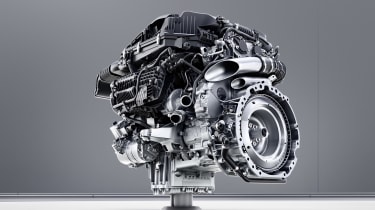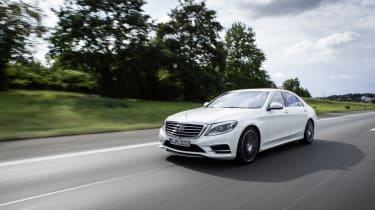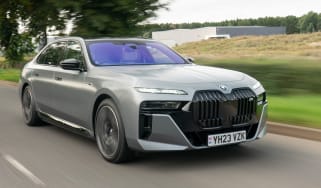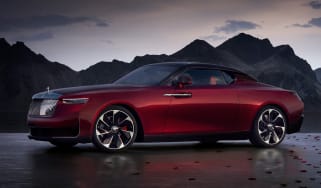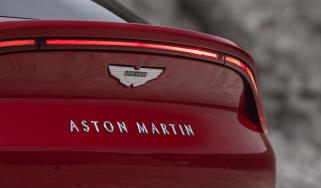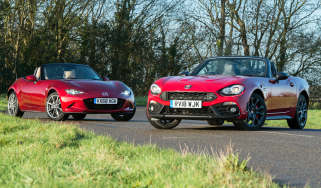New inline six-cylinder heads Mercedes engine strategy
New straight-six petrol and diesel, as well as new fours and a biturbo V8, will debut in next year's S-class
Mercedes-Benz will ditch V6 engines for a pair of new inline six-cylinder units as part of its new modular engine family, rolling out over the next few years.
Joining new four- and eight-cylinder units, each of the engines has a uniform cylinder spacing and each will be designed with electrification in mind, both in terms of mild-hybrid ‘starter generator’ vehicles and plug-in cars.
Of the new units it’s the “M 256” petrol six that’s most intriguing. Mercedes hasn’t used inline-six engines in its passenger cars since cars like the first-generation C-class, W210 E-class and W220 S-class, replaced over time by easier-to-package V6s.
Ironically, packaging is at least partly the reason the inline-six is making a comeback. For one, the use of electrification for auxiliary components (for the purpose of reducing load on the engine, saving fuel) means there is no need to package a belt drive for ancillaries, shortening the length of the straight-six.
> More: 300-mile electric and fuel-cell cars in Mercedes' future
As the inline engine is narrower than a V6, there’s also more space to the sides of the engine. This space is important for what Mercedes calls ‘near-exhaust after treatment’, - which includes items like catalytic converters - which are better placed as close to the engine as possible to enable them to come up to working temperature quickly, beneficial for emissions purposes.
Changes to the ancillary systems in particular have become possible thanks to a new 48-volt electrical system, which can supply energy for high-output systems like air conditioning, active anti-roll bars and notably, Mercedes’ ISG (“integrated starter alternator”) system.
Similar to Honda’s old IMA hybrids the ISG slots an electric motor between the engine and transmission. It’s used to start the engine, but also assists in acceleration (helping reduce load where necessary), recovers engergy when decelerating, and even helps control idle speed. Furthermore, the 48V system is used to run an electric turbocharger - spinning it at speeds of up to 70,000rpm within 300 miliseconds - to provide boost before the conventional turbocharger gets up to speed.
The new engine is broadly as powerful as the firm’s V8s, making 402bhp and over 369lb ft of torque, yet CO2 emissions are reduced more than 15 per cent compared to the V6.
The other inline-six is a new OM 656 diesel, which shares much of its construction with the similarly new OM 654 four-cylinder diesel. Both use unusual “stepped bowl” pistons whose design improves thermal loading across the surface of the piston and facilitates more efficient burning.
A low-friction “Nanoslide” coating on the cylinder walls brings about further improvements and notably, both engines have been designed to meet upcoming Real Driving Emissions measurements - in other words, neither should produce greater real-world emissions than they generate on the test bed.
Along with a new four-cylinder petrol, the other new arrival is the M 176 twin-turbocharged V8. Making its debut next year in a refreshed version of the S-class, the 4-litre unit develops 469bhp, 20bhp more than its 4.6-litre predecessor, yet uses over 10 per cent less fuel.
> Also read: Mercedes-Benz X-class brings premium quality to the pickup class
It also uses cylinder deactivation to further reduce fuel use, closing the intake and exhaust valves of cylinders 2, 3, 5 and 8 via actuators on the camshafts, simultaneously cutting ignition and fuel. A special pendulum reduces vibration whether the engine is running on all eight cylinders or just the four.
Both the new twin-turbocharged V8 and the turbocharged, 48V-assisted inline-six petrol also incorporate particulate filters. Previously the preserve of diesel engines, these filters cut down on emissions of fine soot particles produced in petrol combustion.
As has become traditional with new Mercedes technology, the first vehicle to home all the new power units is will be the 2017 Mercedes-Benz S-class - but we’ll see them filter down the range over the following few years.
evo Comment
It's difficult not to feel a little excitement that Mercedes is bringing back its inline-six cylinder engines.
For well over a decade, V6 engines have predominated when it came to six-cylinder units - not just at Mercedes, but across the industry, with only stragglers like BMW, Volvo and Jeep maintaining the straight-six format in the intervening period - and even then, only BMW still uses the layout.
V6 engines have traditionally been easier to package. While wider than an inline engine across the vee, they're short along the crank, so easy to slot into engine bays that might conventionally house inline four-cylinder engines, even in some transverse, front-wheel drive applications.
But V6 engines aren't as smooth as their inline counterparts, which are near-perfectly balanced, and as emissions equipment becomes more important their width now starts to count against them for packaging.
And from a purely emotive perspective, V6s just aren't quite as appealing. While there have been some fantastic V6 engines in the past, their packaging benefits mean more modern offerings rarely rate highly on lists of the all-time great engines. Inline sixes, on the other hand, have a long history in some of the world's most desirable performance cars, thanks largely to the efforts of BMW.
Smooth and free-revving, they should be ideally suited to Mercedes' new passenger cars, and with low-friction internals and electrification, they should be both powerful and frugal too.


